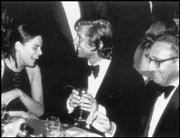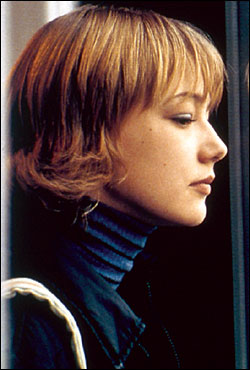THE KID STAYS IN THE PICTURE
directed by Nanette Burstein and Brett Morgen
with Robert Evans
opens Aug. 9 at Metro and Uptown
Want a ringside seat for the way Hollywood really was during its last golden era—the time of Rosemary’s Baby, the first two Godfathers, and Chinatown? Try The Kid Stays in the Picture, an opulent, hypnotic portrait of producer Robert Evans, whose life from Paramount mogul to drug-bust pariah to reinstated icon is a three-act kitsch opera.
Although Nanette Burstein and Brett Morgen are documentarians (their On the Ropes was an Oscar nominee), Kid is more an affectionate portrait than a doc. It’s Evans’ unchallenged vision of Evans, lifted straight from his 1994 memoir and subsequent books-on-tape version (read by Evans himself). An instant hit within Hollywood, the six-hour audiotape is cocky and disarmingly self-deprecating, with insider stories of power brokers and bimbos that have an authentic ring. So does the movie.
As Kid‘s red velvet curtains part, Evans’ voice sets up its premise: “There are three sides to every story—my side, your side, and the truth. And no one is lying.” At 93 minutes, it’s a mightily compressed story, although it’s clear that Evans must have been born charismatic, since he certainly wasn’t born rich in ’30s New York. Yet by the time Evans was 25, he and his older brother were rich from their Evan-Picone line of women’s sportswear.
Hollywood discovered Evans twice: first as an actor, then as an executive. In 1957, Norma Shearer picked the seal-sleek businessman from a swimming pool to play her dead husband, MGM mogul Irving Thalberg, in The Man of a Thousand Faces. Later the same year, Darryl Zanuck saw Evans dancing the tango at El Morocco and decided he’d found his Spanish bullfighter for The Sun Also Rises. The cast’s fury over Zanuck’s choice showed Evans what movie muscle was. Everyone wanted the amateur out until the 5-foot-3 Zanuck, watching Evans’ bullfighting passes in a Mexican arena, announced through his megaphone, “The kid stays IN the picture!”
“That’s when I learned what a producer was—the boss,” Evans says reflectively. “I knew I was a half-assed actor” (believe him here). “What I wanted to be was the next Darryl F. Zanuck.”
Before the next decade was over, he damn near was. As a producer wanna-be, Evans began going for writers, not stars—the reverse of today’s disastrous practice. His second discovery came via a flattering 1966 New York Times profile that caught the eye of Charles Bludhorn, head of Gulf+ Western, the first conglomerate to move into the picture business with its acquisition of Paramount. Bludhorn sent “the kid” to London to learn the biz, then yanked him back to become the studio’s head of production. Old Hollywood reeled.
Kid‘s larger-than-life story has footage to match. It doesn’t get much better than Evans’ filmed pitch to the Gulf + Western board when it threatened to scrap the studio early in his tenure. With Love Story in the can for Christmas and The Godfather going into production, Evans got Mike Nichols, the day’s hot director, to fly out and direct him in 10 minutes of schmaltz and persuasion—a performance canny enough to save Paramount (and his own job).
Still to come were Serpico, Downhill Racer, Paper Moon, Harold and Maude, Godfather II, and Chinatown—many with Evans as hands-on, gloves-off producer. Paramount leapt from ninth to first place at the box office.
With Evans narrating in his husky honeyed voice, John Bailey’s romantic camera swoops through Evans’ beloved house—the one constant through his five marriages (Ali MacGraw was No. 3). Bailey makes that house another character: candlelit and welcoming in the good days; deserted and leaf-blown during Evans’ bleak drug decade of the ’80s.
In between, the screen is filled with enough rare behind-the-scenes photos and footage (like Mia Farrow’s fey little private dance at the time they were working on Rosemary’s Baby) and tell-all anecdotes (Farrow again) to make us feel like insiders—the ultimate seducer’s ploy. There are stories of rare Hollywood loyalty, too, like Jack Nicholson’s heroics to get his pal’s house back for him during Evans’ near bankruptcy.
Watching Evans selling “his” movie now—on every venue except the Shopping Network—you want him not to press so hard. You squirm for him when he tells Katie Couric how lucky he is to be there “with such a beautiful blonde.” Then you realize, this is quintessential Evans—he can’t do it any other way. It’s the same drive that fueled his recovery from a stroke five years ago. It’s what’s kept him in the picture all these years.
info@seattleweekly.com 








